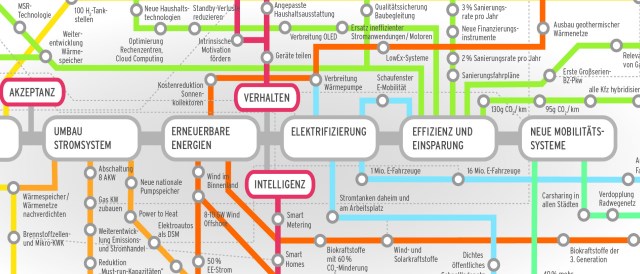Last December, the IFEU Institute of Heidelberg co-published a roadmap for the Energiewende. Martin Pehnt, a co-author of this website, helped direct the project. Craig Morris says the ideas are quite practical.

Mapping the detailed need for change in a different way: IFEU’s Energiewende roadmap. (Photo: IFEU)
It is often claimed that Germany’s energy transition does not have a roadmap, but that’s not completely true. On the one hand, the country, like all EU member states, has a Renewables Action Plan, though that only stretches up to 2020 and does not cover all fields. The Environmental Ministry’s Leitstudie 2011 is more exhaustive.
Nonetheless, a lot of details remain unclear. A roadmap proposal published in December (PDF, unfortunately only in German) by IFEU and Fraunhofer IBP aims to fill that gap. It recommends a focus on onshore wind power distributed throughout the country and calls for a reduction of “must-run” capacity (such as nuclear). It also discusses the need for efficiency, energy democracy, and a shift to electric mobility – and mentions one of Martin Pehnt’s favorite topics: changing behavior and raising energy awareness. For instance, people would begin sharing everything from cars to household appliances.
Obviously, I cannot do justice to all of the details, so I will focus on the issue in my previous post: why Germany’s focus on storing solar power in batteries is misguided.
The new roadmap starts (see page 4 of this PDF) with “power to heat” – essentially, what the Danes also plan for their even more ambitious switch to 100 percent renewable energy (Germany’s target for 2050 is only 60 percent). Essentially, excess wind and solar power can be used to heat up water inexpensively, with hot water being easy to store. But of course, the excess wind power the Danes have will be much cheaper than the excess wind and solar power in Germany.
By 2020, the researchers expect electric mobility to play a role in demand management. In line with Agora’s recent study, stationary battery storage – exactly what Germany is now promoting for solar – does not kick in until 2030. Finally, in the 2020s Germany would expand its own pumped storage before setting up connections to the more significant pumped storage capacity in the Alps and Scandinavia. This scenario is also frequently discussed, though the current situation is that Swiss utilities are actually complaining about German renewables reducing the price of power to unprofitable levels. For Germany to encourage Switzerland to provide more hydropower storage, a way must therefore first be found to make these transactions profitable – a reversal of the current trend.

On Saturday, June 8, the power prices in both Germany and Switzerland were slightly below the level of baseload power, and in both cases the difference was so slight as to make pumped storage unprofitable. In fact, power prices are slow low that generation does not pay for itself either. Source: EEX
Finally, there is the long-term vision of power-to-gas (P2G). As the study reiterates, Germany’s existing natural gas network has sufficient storage capacity for seasonal storage, meaning that excess electricity from the summer (mainly solar) could be stored for the winter as a gas in existing natural gas lines. The gas could then be used for any purpose for which natural gas is currently used: heat generation, cooking, motor fuels, power production, etc. But this ultimate vision does not kick in until the mid-2030s. In my next post, I take a skeptical look at what the price of P2G will have to be to be competitive.
Craig Morris (@PPchef) is the lead author of German Energy Transition. He directs Petite Planète and writes every workday for Renewables International.
[…] article was originally published on the Energiewende blog Energy Transition. Reproduced with […]
What gas are the Germans planning to use for “Power to Gas” ?
Surely not hydrogen, which cannot use natural gas pipelines, compressors, etc. etc.
Excess electricity > water hydrolysis > hydrogen > ammonia synthesis would be my preferred route with methanol a secondary choice.
Alan, they are indeed converting the hydrogen into methane in a fairly straightforward process (exposure to ambient air): http://www.renewablesinternational.net/worlds-largest-p2g-facility-ramps-up/150/537/68394/